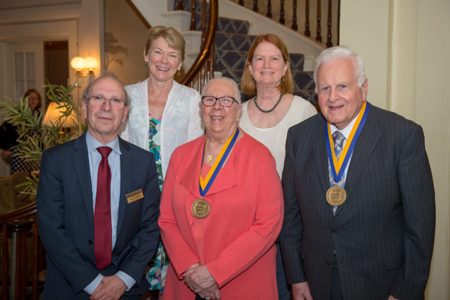
Top row: President Sarah Mangelsdorf, Dr. Alice Pentland; Bottom row: Dr. Mark Taubman, Carol Goldsmith, Dr. Lowell Goldsmith)
A lead gift from Dr. Lowell A. Goldsmith '02M (MPH) and his wife, Carol, establishes the endowed Carol A. and Lowell A. Goldsmith Professorship in Dermatology at the University of Rochester Medical Center (URMC). The gift will provide permanent support to faculty in the department.
In honor of the Goldsmiths' generosity, on August 3rd, the department hosted the Lowell and Carol Goldsmith Symposium, which featured nationally recognized scholars, alumni, and University of Rochester Medical Center faculty. President Sarah Mangelsdorf also presented the Goldsmiths with University medallions in commemoration of their professorship gift.
"Dr. Goldsmith has made such a mark on this department, the Medical Center, and the field of dermatology overall," says Dr. Alice Pentland, the James H. Sterner Chair in Dermatology. "This gift is testimony to that unwavering commitment, and the Goldsmiths' willingness to 'pay it forward' to make the department even better in the future. We are incredibly grateful for their support."
"Throughout my 21 year career at Rochester, I saw the effect that endowed professorships had on people, programs, and the entire University," says Dr. Goldsmith. "Carol and I hope that this gift will serve as a catalyst for others, to establish funds that will forever keep the University at the forefront of research, education, and patient care," says Dr. Goldsmith.
Dr. Goldsmith joined the URMC faculty in 1981 as the first James H. Sterner Chair in Dermatology. He became the founding chair of the dermatology department, which was officially established in 1987. In 1996, Dr. Goldsmith was appointed dean of URMC's School of Medicine and Dentistry and, in 2000, he became dean emeritus.
Dr. Goldsmith's research interests span the genetics and biochemistry of skin disease and developing new drugs for the treatment of genetic skin disorders. He is a recognized leader in his field, and has served as president of the Association of Professors in Dermatology, which hosts the Lowell Goldsmith Lectureship annually. He has also served as a member of the board of directors of the American Academy of Dermatology and director of the American Board of Dermatology.
Dr. Goldsmith received his bachelor's degree from Columbia University and his medical degree from SUNY Downstate College of Medicine (Brooklyn). He has served on faculty at Duke University, Harvard University, and the University of North Carolina at Chapel Hill. In 1999, he cofounded Virtual DX with Arthur Papier, a former dermatology resident at the University. Virtual DX is a Rochester, NY-based digital imaging company and a recognized leader in medical knowledge management.
The Goldsmiths have two adult daughters and enjoy traveling the world. Dr. Goldsmith is also an accomplished metalsmith who crafts silver art objects.